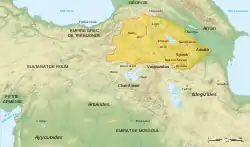Zakarid Armenia Զաքարյան Հայաստան | |||||||||||
|---|---|---|---|---|---|---|---|---|---|---|---|
| 1201–1350 | |||||||||||
 Coat of arms
| |||||||||||
 Zakarid territories in the early 13th century[1] | |||||||||||
| Capital | Ani | ||||||||||
| Common languages | Armenian | ||||||||||
| Religion | Armenian Apostolic | ||||||||||
| Government | Monarchy | ||||||||||
| Zakarids | |||||||||||
| Historical era | Middle Ages | ||||||||||
• Established | 1201 | ||||||||||
• Conquered by Chobanids | 1350 | ||||||||||
| |||||||||||
| History of Armenia |
|---|
 Coat of Arms of Armenia |
| Timeline • Origins • Etymology |
| Part of a series on the |
| History of Georgia |
|---|
.jpg.webp) |
Zakarid Armenia[2][3] (Armenian: Զաքարյան Հայաստան, romanized: Zakaryan Hayastan) alternatively known as the Zakarid Period, describes a historical period in the Middle Ages during which the Armenian vassals of the Kingdom of Georgia were ruled by the Zakarid-Mkhargrzeli dynasty.[4] The city of Ani was the capital of the princedom. The Zakarids were vassals to the Bagrationi dynasty in Georgia, but frequently acted independently[5] and at times titled themselves as kings.[6][7] In 1236, they fell under the rule of the Mongol Empire as a vassal state with local autonomy.
During the reign of George V and Bagrat V, the Zakarid territories once again reverted to the Kingdom of Georgia.[8][9] The Zakarid dynasty continued to rule Ani until around 1350, when it was conquered and ravaged by the Chobanids.[10]
History
Following the collapse of the Bagratuni dynasty of Armenia in 1045, Armenia was successively occupied by Byzantines and, following the Battle of Manzikert in 1071, by the Seljuks.[11] Khosrov, the first historically traceable member of the Zakarid family, moved from Armenia to southern Georgia during the Seljuk invasions in the early 11th century. Over the next hundred years, the Zakarids gradually gained prominence at the Georgian court, where they became known as Mkhargrdzeli (Long-shoulder) or in Armenian: Երկայնաբազուկ, (Yerkaynabazuk). A family legend says that this name was a reference to their Achaemenid ancestor Artaxerxes II the "Longarmed" (404–358 BC).[12][13]
During the 12th century, the Bagratids of Georgia enjoyed a resurgence in power, and managed to expand into Muslim-occupied Armenia.[14] The former Armenian capital Ani would be captured five times between 1124 and 1209.[15] Under King George III of Georgia, Sargis Zakarian was appointed as governor of Ani in 1161. In 1177, the Zakarids supported the monarchy against the insurgents during the rebellion of Prince Demna and the Orbeli family. The uprising was suppressed, and George III persecuted his opponents and elevated the Zakarids.
Despite some complications in the reign of George III, the successes continued in the reign of the Queen Tamar.[14] This was chiefly due to the Armenian generals Zakare and Ivane.[16][17] Around the year 1199, they retook the city of Ani and established their semi-independent Armenia, and in 1201, Ani became the capital of Zakarid Armenia.[14][18] Armenia was often governed as an independent state by the Zakarians.[6] The volume of trade seems to have increased in the early 13th century, and under the Zakarid princes the city prospered, at least until the area was occupied by the Mongols in 1237. The Zakarians amassed a great fortune, governing all of northern Armenia; Zakare and his descendants ruled in northwestern Armenia with Ani as their capital, while Ivane and his offspring ruled eastern Armenia, including the city of Dvin. Eventually, their territories came to resemble those of Bagratid Armenia.[11]
Zakare and Ivane commanded the Georgian-Armenian armies for almost three decades, achieving major victories at Shamkor in 1195 and Basian in 1203 and leading raids into northern Persia in 1210.
When the Khwarazmian Empire invaded the region, Dvin was ruled by the aging Ivane, who had given Ani to his nephew Shahnshah, son of Zakare. Dvin was lost, but Kars and Ani did not surrender.[14]
However, when Mongols took Ani in 1236, they had a friendly attitude towards the Zakarids.[14] They confirmed Shanshe in his fief, and even added to it the fief of Avag, son of Ivane. Further, in 1243, they gave Akhlat to the princess T’amt’a, daughter of Ivane.[14]
After the Mongols captured Ani in 1236, the Zakarids ruled not as vassals of the Bagratids, but rather the Mongols.[11] The later kings of Zakarids continued their control over Ani until the 1360, when they lost to the Kara Koyunlu Turkoman tribes, who made Ani their capital.[11]
Autonomy
The Zakarid generals formed an Armenian state, restoring independence to the historic lands of Armenia.[5][19] While they were vassals of the Georgian king, the Zakarids often acted independently and established their own political and tax systems. Their allegiance to the Georgian kings was mostly confined to providing the kings with military assistance during times of war.[5] In their capital city of Ani, they named themselves the “Kings of Ani” exemplifying their independent ambitions from the Kings of Georgia.[7] Following the Mongol conquest in 1236, Georgia and the Zakarid principality were organized into a province broken down into 8 administrative units (tumans). 5 of the tumans were Georgian while the remaining 3, composed of the Zakarid principality in Kars and Ani, as well as, the Awagids in Syunik and Artsakh, were Armenian.[20] From 1236 to 1246, the Mongols did not interfere with the governing structure of the Zakarid state and appointed the Zakarids as heads of the tumans.[20] While Zakarid Armenia was a vassal state of the Mongols and therefore subject to taxes and loyalty to the Khan, they were otherwise left to govern themselves and had relative autonomy during this period.[21]
References
- ↑ Bournoutian 1993, p. 137, Map 18.
- ↑ Dashdondog 2010, pp. 103, 106, 109, 114.
- ↑ Šahnazaryan, Armen (2011). Zakaryan, Anushavan (ed.). "Zakarid Armenia in the First Era of the Ilkhanate". Patma-Banasirakan Handes (in Armenian). Armenia: Armenian National Academy of Sciences (1): 129–140. ISSN 0135-0536.
- ↑ Chahin, Mack (2001). The Kingdom of Armenia: A History (2. rev. ed.). Richmond: Curzon. p. 235. ISBN 0700714529.
The most influential lords of north-eastern Armenia were members of the Zakarian family. Hence, the first half of the thirteenth century is known as the Zakarid Period...Although of Armenian foundation, members of that family held eminent positions among the Georgian lords.
- 1 2 3 Grekov, Boris, ed. (1953). Очерки истории СССР. Период феодализма IX-XV вв.: В 2 ч. [Essays on the history of the USSR. The period of feudalism IX-XV centuries: In 2 volumes]. Moscow: Academy of Sciences of the Soviet Union. OCLC 8470090.
…the political power of the Zakarids was formed and strengthened, heading the restored Armenian statehood in indigenous Armenia. The territory subject to the Zakarids was an Armenian state, vassal to the then reigning house of the Georgian Bagratids; The Zakharid government had the right to court and collect taxes. The main responsibility of the Armenian government to the Georgian government was to provide it with military militia during the war.
- 1 2 Strayer, Joseph (1982). Dictionary of the Middle Ages. Vol. 1. p. 485.
The degree of Armenian dependence on Georgia during this period is still the subject of considerable controversy. The numerous Zak'arid inscriptions leave no doubt that they considered themselves Armenians, and they often acted independently.
- 1 2 Eastmond, Antony (2017). Tamta's World. Cambridge University Press. p. 26.
In one inscription on the palace church on the citadel of Ani, the brothers' principal city and the former capital of Armenia, they refer to themselves as 'the kings of Ani', suggesting loftier ambitions, independent of Georgia, and in the inscription at Haghartsin quoted in the first chapter, they claimed descent from the Bagratunis, the Armenian kings of the region until the eleventh century.
- ↑ W. Barthold, ' Die persische Inschrift an der Mauer der Manucehr-Moschee zu Ani ', trans. and edit. W. Hinz, ZDMG, Bd. 101, 1951, 246;
- ↑ Ivane Javakhishvili, The History of the Georgian Nation, vol. 3, Tbilisi, 1982, p.179
- ↑ Dadoyan 2018, p. 432 “Ani oscillated between being ruled by Georgians, Shaddädids and Seljugs, all equally violent, until the rise of the Georgian-Armenian Zakarid dynasty at Shirak (1201-C. 1350).”.
- 1 2 3 4 Sim, Steven. "The City of Ani: A Very Brief History". VirtualANI. Retrieved 2007-07-15.
- ↑ Armenian Soviet Encyclopedia, 3th volume
- ↑ Paul Adalian, Rouben (2010). Historical Dictionary of Armenia. p. 83.
- 1 2 3 4 5 6 Minorsky, Vladimir (1953). Studies in Caucasian History. New York: Taylor’s Foreign Press. pp. 102–103. ISBN 978-0-521-05735-6.
- ↑ Chisholm, Hugh, ed. (1911), , Encyclopædia Britannica, vol. 2 (11th ed.), Cambridge University Press, p. 47
- ↑ "The Yezidi Kurds and Assyrians of Georgia - The Problem of Diasporas and Integration into Contemporary Society" (PDF). Retrieved 2023-08-26.
- ↑ Suny 1994, p. 39.
- ↑ Dadoyan 2018, p. 438.
- ↑ Thomson, Robert (2014). "From Theology to Law: Creating an Armenian Secular Law Code". In Pirie, Fernanda; Scheele, Judith (eds.). Legalism: Community and Justice. Oxford: Oxford University Press. pp. 25–46. ISBN 9780191785108.
The region at the time was under Georgian suzerainty, but the Zakarid princes, Zakaré and Ivané, maintained local Armenian independence.
- 1 2 Dashdondog 2010, p. 102.
- ↑ Hodous, Florence (2018). "Inner Asia 1100s-1405: The Making of Chinggisid Eurasia". In Fairey, Jack; Farell, Brian (eds.). Empire in Asia: A New Global History: From Chinggisid to Qing. Vol. 1. London: Bloomsbury Academic. p. 20. ISBN 9781472591234.
Vassal states such as the Uyghur kingdom of Qocho (until 1335), Zakarid Armenia, Cilicia, Georgia, and Korea similarly owed the empire taxes, troops, and loyalty, but were otherwise left to govern themselves.
Bibliography
- Bournoutian, George (1993). A History of the Armenian People: Pre-History to 1500 A.D. Vol. 1. Costa Mesa, CA: Mazda Publishers. ISBN 0939214962.
- Dadoyan, Seta (2018). "Samuel Anets'i and his continuators". In Thomas, David; Chesworth, John A. (eds.). Christian-Muslim Relations. A Bibliographical History. Volume 12 Asia, Africa and the Americas (1700-1800). Vol. 12. Germany: BRILL. pp. 426–447. ISBN 9789004384163.
- Dashdondog, Bayarsaikhan (2010). "Mongol Administration in Greater Armenia (1243–1275)". In Drompp, Michael; Deweese, Devin (eds.). The Mongols and the Armenians (1220-1335). Brill's Inner Asian Library. Vol. 24. Leiden: Brill. pp. 99–120. doi:10.1163/9789004192119_006. ISBN 978-90-04-19211-9.
- Suny, Ronald Grigor (1994). The Making of the Georgian Nation. Indiana University Press. pp. 39–40. ISBN 0-253-20915-3.
.svg.png.webp)